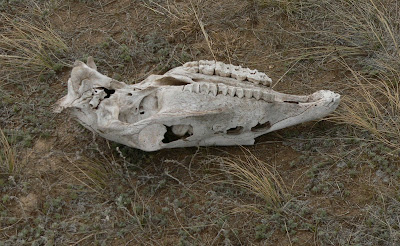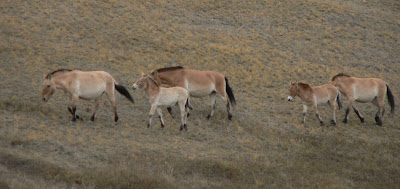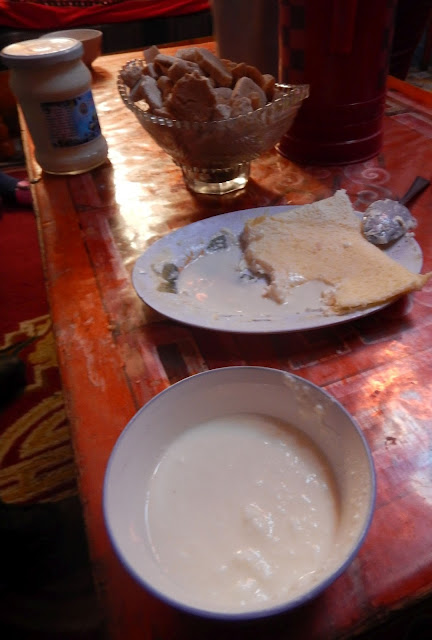Dust flux, Vostok ice core

Two dimensional phase space reconstruction of dust flux from the Vostok core over the period 186-4 ka using the time derivative method. Dust flux on the x-axis, rate of change is on the y-axis. From Gipp (2001).
Friday, December 30, 2016
Tuesday, December 27, 2016
Wild horses of Mongolia
The nomadic life
Hustai National Park is south of Ulaanbaatar. There is a series of sand dunes just outside the park entrance, which acts as a first stop on most tours.
This is the sort of place where they hang out. When we went there, summer had just ended, and the days were beginning to get cold. The horses had a preferred area of the park in the summer, but tended to roam elsewhere when the weather turned cold. The guides weren't sure which of the two places the horses would be. Suffice it to say they weren't where we went at first.
Somewhere in there is a red deer.
After waiting for some time amongst the natural bonsai of the steppe, we retreated to the visitor's centre for a traditional meal. Our guides conferred with other guides, but nobody had seen any wild horses over the past few days. They decided to have us wait until the last group in the park came out.
Success! They had seen them. The horses had gone to a spot quite close to where we had been waiting for them. So back into the vehicles and over to a spot where the stream was incised quite steeply into the steppe.
The horses move in family groupings, with normally one male and a few females and foals.
Sunday, December 18, 2016
The second part of Terelj
Continuing through Terelj National Park . . .
Part of the experience on the tour was to visit one of the local families in their ger. Now, it's true, there is a certain level of artifice to the entire experience, but it was better than staying in the ger camp, which was entirely artificial.
The family had at least five children, and for some reason, there was an old school bus parked in their camp. (I was about to say 'on their property' - except they don't actually have "property" as we understand it).
After awhile, we were invited inside the ger. The father started up the fire in the stove in the middle of the tent, and then everyone went outside for a bit. From time to time, the younger sister would open the door, lean in and scream "Hello!" and then slam the door and run away. After about the third time, I crept over to the door so I was in the doorway when she opened the door. When she saw me, she ran away screaming.
More children arrived on horseback. That's the older sister hiding behind her mother.
Some children in Mongolia are naturally blonde.
Assorted dairy made at the camp. Yoghurt at bottom, something like butter at middle (not quite churned enough to be butter, I think), and in the bowl, dried yoghurt. After making the yoghurt, they would spread it out on a surface until it dried.It was terrible. I highly recommend it.
Nomadic families tend to have herds--usually horses, cattle, yak, or sheep.
Eventually, we left to visit other sites at the park. As we drove off, the children chased us, shouting "Goodbye!" Our guide was impressed. "They really like you!"
Not far away is the Aryabal Meditation Centre, an old Buddhist monastery about half-way up a hill
You can spin the wheel of fortune, and get a number. Then you wander along the path looking for the aphorism that goes with your number.
Spinning prayer wheels is a common practice at the centre, but I'm not convinced people are really praying.
There were people praying inside. As in most Buddhist temples, there were central icons, and numerous arhats on the walls.
Part of the experience on the tour was to visit one of the local families in their ger. Now, it's true, there is a certain level of artifice to the entire experience, but it was better than staying in the ger camp, which was entirely artificial.
The family had at least five children, and for some reason, there was an old school bus parked in their camp. (I was about to say 'on their property' - except they don't actually have "property" as we understand it).
So while we waited in the car for our guide to negotiate the terms of our visit, three of the children hid in the bus, popping out episodically to scream, "Hello!", after which they would hide in the bus again. I ducked below the window in the car for awhile, until my travelling companion told me they were looking for me.
After awhile, we were invited inside the ger. The father started up the fire in the stove in the middle of the tent, and then everyone went outside for a bit. From time to time, the younger sister would open the door, lean in and scream "Hello!" and then slam the door and run away. After about the third time, I crept over to the door so I was in the doorway when she opened the door. When she saw me, she ran away screaming.
There she is, the little rascal.
More children arrived on horseback. That's the older sister hiding behind her mother.
Some children in Mongolia are naturally blonde.
Assorted dairy made at the camp. Yoghurt at bottom, something like butter at middle (not quite churned enough to be butter, I think), and in the bowl, dried yoghurt. After making the yoghurt, they would spread it out on a surface until it dried.
Nomadic families tend to have herds--usually horses, cattle, yak, or sheep.
Eventually, we left to visit other sites at the park. As we drove off, the children chased us, shouting "Goodbye!" Our guide was impressed. "They really like you!"
Turtle Rock
Yellow
Not far away is the Aryabal Meditation Centre, an old Buddhist monastery about half-way up a hill
Rock paintings at the Meditation Centre.
You can spin the wheel of fortune, and get a number. Then you wander along the path looking for the aphorism that goes with your number.
Spinning prayer wheels is a common practice at the centre, but I'm not convinced people are really praying.
There were people praying inside. As in most Buddhist temples, there were central icons, and numerous arhats on the walls.
View from the monastery
Monday, December 12, 2016
Warming up
For another fight.
The trainer gets the two roosters worked up by letting them fight for a few seconds before stopping them.
The trainer gets the two roosters worked up by letting them fight for a few seconds before stopping them.
Sunday, December 11, 2016
Modern art in Zhengzhou
I am not a huge fan of modern art, as I mostly don't understand it. But, here was a brand new display in a brand new building in Zhengzhou, so let's go explore.
The display was in the twin of the above building. Interestingly, both buildings were not yet open to the public, as they weren't yet complete. There was construction detritus all over the floors, and only freight elevators were working. But they had displays at roughly nine-floor intervals (corresponding to the levels with the notches in the above picture--which are accessible outdoor patios, which I presume will have guardrails installed once open to the public). But maybe not--in China, you are expected to look after yourself to a large extent, and third-party liability is extremely limited.
I'm not sure if the dirt and the pail are part of the exhibit or not. I'm leaning towards yes. I think it is meant as a reminder that all modern construction sites may potentially encounter cultural relics of the past. It is not uncommon to see construction workers wandering the streets near their workplace trying to hawk old pieces of porcelain or bronze.
A couple of young women try their luck with the auto-decapitator.
Inside--a cityscape maybe?
Some exhibits moved. The motion of some was tied to motion detectors.
Chinese herbal medicine products on woofers, which would hum (vibrating the herbs) every so often.
I have no explanation for this.
A self-portrait. I don't know if the smashed mirror was part of the display or not.
Viewers reacted favourably to the saliva-collection experiment.
My favourite was the liquid-metal pterodactyl. It flapped its wings to the chiming of a bell, but was hooked up to a motion detector which switched it off when anyone looked at it too closely.
Possibly art. Or maybe spilled insulation.
Subscribe to:
Posts (Atom)
























































